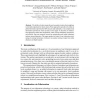Free Online Productivity Tools
i2Speak
i2Symbol
i2OCR
iTex2Img
iWeb2Print
iWeb2Shot
i2Type
iPdf2Split
iPdf2Merge
i2Bopomofo
i2Arabic
i2Style
i2Image
i2PDF
iLatex2Rtf
Sci2ools
ICINCO
2008
2008
Trilateration Localization for Multi-robot Teams
The ability of robots to quickly and accurately localize their neighbors is extremely important for robotic teams. Prior approaches typically rely either on global information provided by GPS, beacons and landmarks, or on complex local information provided by vision systems. In this paper we describe our trilateration approach to multi-robot localization, which is fully distributed, inexpensive, and scalable. Our prior research focused on maintaining multi-robot formations indoors using trilateration. This paper pushes the limits of our trilateration technology by testing formations of robots in an outdoor setting at larger inter-robot distances and higher speeds.
Complex Local Information | ICINCO 2008 | Multi-robot Formations Indoors | Multi-robot Localization | Robotics |
| Added | 29 Oct 2010 |
| Updated | 29 Oct 2010 |
| Type | Conference |
| Year | 2008 |
| Where | ICINCO |
| Authors | Paul M. Maxim, Suranga Hettiarachchi, William M. Spears, Diana F. Spears, Jerry C. Hamann, Thomas Kunkel, Caleb Speiser |
Comments (0)

